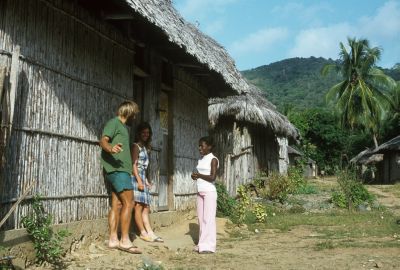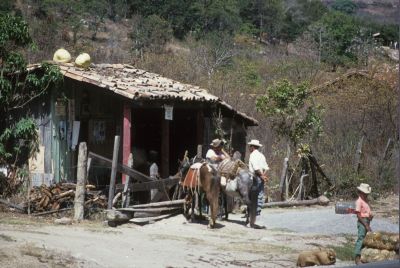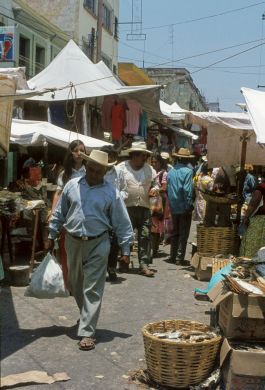| home | site map | world | children | recent | cooking | dutch | german | react | ||||||||||||
South and North-America 2 (1973/74).

Panama: waiting for our passports to return with visum, we stayed with Conchita
A
narrow road through dense jungle led to the Caribbean sea and ended there. The thin stretch of land joining North and South-America was virgin jungle still, road nor path had been cut through and stories of maneating Indians living there, were being told. By way of a little sailing boat and a dugout canoe we managed to come to the border of Panama. A bigger ship was supposed to arrive for further transport to Panama City, where the road started again, but no ship turned up as Carnaval had started. Five days we spent in a local hut. To be able to fly with a four seats plane, we had to dismantle the bikes in the smallest parts possible.At last we arrived in Panama City, but could not continue because of Carnaval, all streets were barred. We camped outside on a sports park with no facilities. To do what was necessary, we retreated in a little bush nearby, where in the early morning, I was attacked by a man with no face, he must have had a nylon stocking pulled over it. My voice is in good shape and I made a deafening noise, which made the assaulter run away. A strange end of South-America we thought while cycling over the bridge over the Panama Canal linking it with North-America. Never before there was the faintest sign of attack or even theft to us.

Honduras: transport and travelling is typically done on mules
Coming to Honduras we heard a revolution was planned for the next day. At last we said, we will witness this famous folkloristic custom of the Latin-American countries! Alas, apparently it was cancelled and all stayed quiet.
In Guatamala we plunged into thick jungle again to visit a legendary Mayan city in an endless sea of green. More Mayan cities partly reconstructed, we visited in the Yucatan peninsula of Mexico. This is a country of no rivers, but the Mayan Indians were friendly enough to let us camp amidst their huts, pigs, goats, chickens and dogs plus the use of their well. Or we camped in the middle of a village, where a tap usually was found.

After many thousands of miles the bikes broke down frequently and spare parts were hard to get. In a desertlike part of Northern Mexico a chain broke , which we could not repair. The broken bicycle was tied to the good one and so Henny towed me to the next village.
The first thing we did in the US of course was to replace the worn out parts. Naturally we avoided the main busy highways in this country and travelled the country roads. As usually we went to the farmers to ask for a place to camp, but for the first time in all our travels, we were refused. Never we met so many suspicious people: "Who are you?", "What are you doing on this small country road?", "You better hook up!" was asked and told us frequently and unfriendly. And this was the so-called friendly South. In the North we had none of these problems neither in Canada, that we entered in Windsor. After passing through endless cornfields and monotonous forests, where I fell asleep on the bike, we ended the American continent in Halifax (Nova Scotia).
Mexico: markets had here an abundant choice of fruits and vegetables and stalls to enjoy the hot Mexican food.
| Follow up: Herewith one way of narrating our worldtravels on bicycle has ended. We hope you have enjoyed it so far. Other numbers tell about cycling with children and cooking and camping while travelling with bicycle. These stories and information are in Dutch, but often the pictures have English explanations beneath them. You can read this by pointing at the pictures. We think it will be interesting for English readers as well. As we write and make the sites when we have time, they appear quite irregular, so if you want to be informed about a newly published part please use our contactform or inform us by e-mail: henny.barelds©hccnet.nl
| |
| Site map (nl) | Around the world | Previous | Home | |||